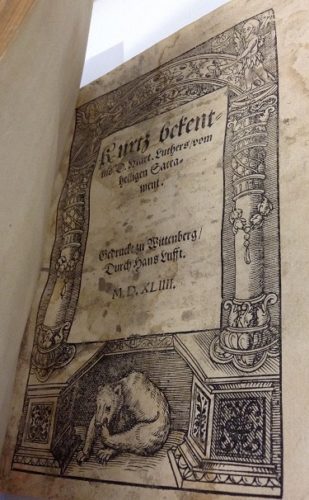To complement the year-long celebrations of the 500th anniversary of the Reformation, the Library has purchased a volume containing five contemporary copies of works by Luther.
Bound together in vellum, the volume contains a German translation of the book of Isaiah, a commentary on Isaiah chapter 53, Kurtz Bekentnis vom heiligen Sacrament (Brief confession concerning the holy Sacrament), Von den Symbolis und Conciliis (a work on the Nicene Creed), and a sermon on John’s Gospel.
All of the titles were printed in Wittenberg, the town in which Luther worked for many years and is now known officially as Lutherstadt Wittenberg. Three of them were printed by Hans Lufft, the printer who also produced Luther’s translation of the Bible. Since Lufft only set up his business in 1523, the last work in this volume must have been one of his first commissions as it was printed that same year.
The translation of Isaiah is heavily annotated, with significant passages such as Chapter 53 almost entirely underlined. Since some of the annotations have been cut off at the edge of the page, it can be deduced that the five titles were not bound together by their first owner, and the plain vellum binding means the book was probably intended for regular use.
There is a short introduction in which Luther explains his approach to translating the text of the Book of Isaiah:
Anyone can easily understand the prophet…we have done our best to make Isaiah speak good, clear German… [my translation]
The next work provides a detailed commentary on the 53rd chapter of Isaiah, with the text of the Bible printed in a typeface twice as large as the text of the commentary.
The blackletter typeface (also called Gothic or Fraktur) was very common in early German printing and remained in use up until the 20th century. It was termed ‘Gothic’ by the Italians who thought those north of the Alps were barbaric, but the style may have been influenced by Arabic script – a legacy of the Crusades.
Kurtz Bekentnis vom heiligen Sacrament was written at the end of Luther’s life, and gives a short outline of Luther’s views on the Eucharist. The following year, his opponent Heinrich Bullinger produced a rebuttal, True confession of the servants of the church at Zurich*. However in this work Luther is particularly disagreeing with Caspar Schwenckfeld (1490-1561), a theologian who had initially supported Luther but came to oppose him on the doctrine of the Lord’s Supper**. In the first paragraph of this work Luther calls Schwenckfeld and his followers ‘slanderers of the sacrament.’
The woodcut illustration for the title page of this work curiously features an image of a bear, licking its foot!
The primary author of the fourth work in this set is not Luther but Caspar Creuziger (1504-1548), a professor at the University in Wittenberg and one of Luther’s main collaborators on the translation of the Old Testament***. The work discusses the doctrines of the Nicene Creed, and is followed by Luther’s translation of the Creed into German.
The last and oldest item is Luther’s sermon on the story in John chapter 4 of the royal official whose son was raised to life by Jesus. Luther uses this miracle to illustrate the nature of faith – Das ist die art und natur des glaubens.
References:
*Lehmann, Martin. Luther’s works vol. 38 St Louis: Concordia, 1968. p. 284.
**ibid p. 282.
***Haemig, Mary Jane (ed.) The Annotated Luther vol. 4 Minneapolis: Fortress Press, 2016. p. 476.



